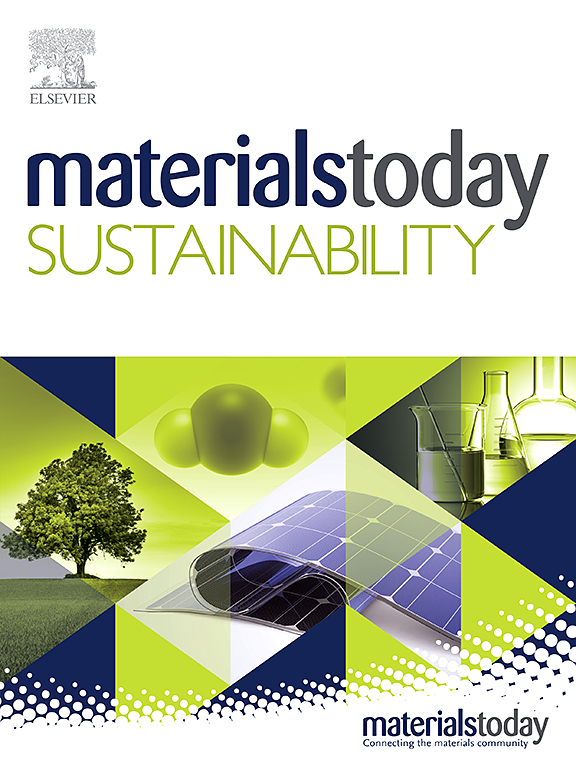下一代基于纳米材料的生物传感器:用于检测新出现的环境污染物的实时生物传感设备
IF 7.1
3区 材料科学
Q1 GREEN & SUSTAINABLE SCIENCE & TECHNOLOGY
引用次数: 0
摘要
在过去几十年中,工业化和城市化加速了环境退化,因此需要采取科学方法进行适当的监测和管理。本文综述了基于纳米材料的生物传感器及其在可持续环境监测中的应用,如检测水中重金属、空气污染物和温室气体、土壤和食物中的农药、生物制剂和病原体的鉴定。例如,基于石墨烯的免疫传感器显示出高水平的电阻率和稳定性,可以在极低的检测限(0.01 ppb)下识别水中的铅离子。同样,含有金纳米粒子的生物传感器对汞离子表现出高度的敏感性;其检出限为0.005 ppb。本文综述了用于生物传感器的纳米材料的尺寸和机械、热、电子、光学和催化的基本特性,使它们有资格用于生物传感器。根据纳米材料的应用前景,介绍了纳米材料与生物分子相互作用的机理,以及设计纳米生物材料时需要考虑的其他重要因素。此外,该综述还强调了该材料在稳定性、可重复性、生物相容性和环境问题方面的当前问题、局限性和未来前景,以及该材料与未来智能多功能系统(如物联网(IoT)、机器学习(ML)和其他创新系统)的集成,以及与规模化和商业化相关的问题。这篇系统的文献综述显示了纳米材料生物传感器在促进实现可持续发展目标(sdg)朝着更健康和可持续的社会方面的潜在作用。本文章由计算机程序翻译,如有差异,请以英文原文为准。
Next-generation nanomaterials-based biosensors: Real-time biosensing devices for detecting emerging environmental pollutants
Over the last few decades, industrialization and urbanization have accelerated environmental degradation and, therefore, require scientific approaches for proper monitoring and management. This review specifically examines biosensors based on nanomaterials and their application in environmental monitoring for sustainable purposes such as detecting heavy metals in water, air-borne pollutants and greenhouse gases, pesticides in soil and foods, identification of biological agents and pathogens. For instance, graphene based immunosensors have shown high level of resistivity and stability, identifying lead ions in water at very low limits of detection, 0.01 ppb. In the same way, biosensors, which contain gold nanoparticles, have shown high sensitivity to the mercury ions; their detection limit reaches 0.005 ppb. This review describes the nanomaterials used in biosensors in terms of their dimensionality and the essential properties of mechanical, thermal, electronic, optical, and catalytic that qualify them for use in biosensors. It also presents the mechanisms of interaction between nanomaterials and biomolecules based on the intended application, and other important factors that need to be considered when designing nanobiomaterials. Furthermore, the review highlights the current issues, limitations, and future prospects of the material in terms of stability, reproducibility, biocompatibility, and environmental concerns, as well as the integration of the material into future smart multi-functional systems such as Internet of Things (IoT), machine learning (ML), and other innovative systems, and issues related to scaling up and commercialization. This systematic literature review shows the potential role of nanomaterial biosensors to enhance the achievement of the sustainable development goals (SDGs) toward a healthier and sustainable society.
求助全文
通过发布文献求助,成功后即可免费获取论文全文。
去求助
来源期刊

Materials Today Sustainability
Multiple-
CiteScore
5.80
自引率
6.40%
发文量
174
审稿时长
32 days
期刊介绍:
Materials Today Sustainability is a multi-disciplinary journal covering all aspects of sustainability through materials science.
With a rapidly increasing population with growing demands, materials science has emerged as a critical discipline toward protecting of the environment and ensuring the long term survival of future generations.
 求助内容:
求助内容: 应助结果提醒方式:
应助结果提醒方式:


